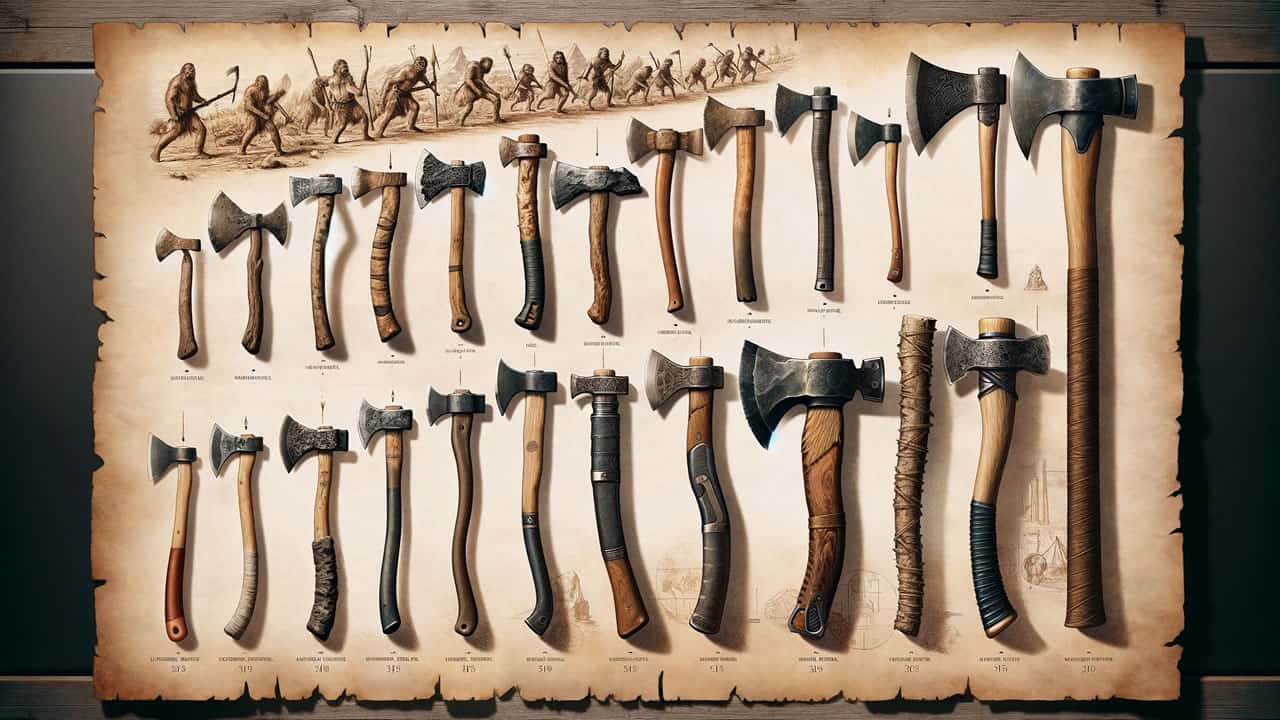
The axe is one of humanity’s oldest and most versatile tools. Its journey from a rudimentary Stone Age implement to a sophisticated modern tool encapsulates human ingenuity and adaptability. This article explores the rich history and evolution of axes, shedding light on how they have shaped and been shaped by human civilization.
The story of the axe begins in the Stone Age, roughly 2.5 million years ago. Early humans discovered that sharp-edged stones could be used for cutting. These were the first rudimentary axes, consisting of unshaped stones. However, as time progressed, Stone Age inhabitants began crafting more sophisticated tools.
Around 6000 to 2000 BCE, during the Neolithic period, humans developed the hand axe. These were made by chipping away at flint or similar stones to create an edge. The hand axe was not attached to a handle and was used for a variety of purposes, including chopping wood, butchering animals, and digging.
The Bronze Age (approximately 3300 – 1200 BCE) marked a significant advancement in axe technology. The discovery of metalworking allowed for the creation of stronger and more durable tools. Bronze axes, characterized by their metal heads attached to wooden handles, were a major step forward. They were sharper, more reliable, and could be used for more demanding tasks, such as clearing forests and constructing wooden structures.
The Iron Age (around 1200 – 500 BCE) introduced iron, a metal stronger and more abundant than bronze. Iron axes represented another leap in technology. They were tougher, could hold a sharper edge, and were more widely available due to the prevalence of iron. These axes were essential in agriculture and were instrumental in the expansion of farmland.
During the Middle Ages (5th to 15th century CE), the axe found its place not only as a tool but also as a weapon. Battle axes were developed, featuring longer handles and heavier heads, designed to break through armor. The Viking axe is a notable example, renowned for its use in warfare.
In daily life, the axe was indispensable in a predominantly agrarian society. It was used in building houses, boats, and carts, as well as for chopping wood and other general tasks. The development of the broadaxe during this period was significant for woodworking, particularly in shaping logs for timber framing.
The Industrial Revolution (18th and 19th centuries) brought about mass production and standardization of tools, including axes. This era saw the emergence of specialized axes for different purposes – such as the ice axe for mountaineering and the firefighter’s axe. The production process also improved, with better-quality steel allowing for stronger and more durable axe heads.
The 20th century did not bring dramatic changes to the axe’s design, but rather refinements. The focus shifted to ergonomics and efficiency. Handle design evolved to reduce user fatigue and increase safety. The double-bit axe, with two edges for different types of cutting, became popular among professional woodsmen.
During this period, the axe started facing competition from modern machinery like chainsaws. However, it remained a staple tool for many, valued for its simplicity and reliability.
Today, axes are experiencing a cultural resurgence. While modern technology has replaced axes in many industrial and professional settings, they remain popular among outdoor enthusiasts, survivalists, and those appreciating traditional craftsmanship.
Modern axes are the culmination of centuries of evolution. They feature high-quality steel, ergonomic handles made from advanced materials, and specialized designs for various applications. Brands like Gränsfors Bruk and Fiskars are known for their high-quality axes, combining traditional craftsmanship with modern materials and design.
The axe’s journey from a simple stone tool to a sophisticated modern implement is a testament to human innovation. Throughout history, the axe has been a companion in human survival, expansion, cultural development, and technological progress. It has evolved in step with our own journey, adapting to our changing needs and environments.
As we move further into the 21st century, the axe remains a symbol of our enduring connection to our past and a tool that continues to find relevance in our present. Its story is not just about the tool itself but about us – a reflection of our journey as a species and our unending quest to shape the world around us.
Axes are tools that have been a vital part of human civilization for thousands of years. Whether used for chopping…
Axes have long held a place in our collective imagination, symbolizing strength, survival, and sometimes even terror. From ancient legends…
Bushcraft axes are a fundamental tool for survival and outdoor enthusiasts. These axes are not just tools for wood chopping…
Chopping wood is a fundamental skill, whether for a seasoned lumberjack, a homeowner managing their firewood supply, or an outdoor…
In the realm of wilderness survival skills, an axe is one of the most versatile tools you can have at…
For anyone involved in wood cutting, whether as a professional or a hobbyist, choosing the right axe is crucial. Axes…